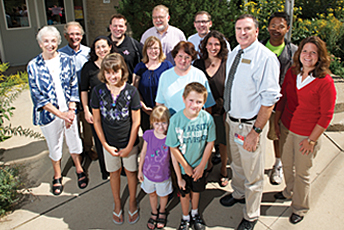For more than 150 years, Lawrence University and the Appleton Area School District have been in the business of educating young people. Through partnership and collaboration, the two institutions have bolstered their common missions of providing the highest quality instruction and rich learning environments for their students.
Lawrence President Jill Beck honored the Appleton Area School District Oct. 9 with the third annual Lawrence University Collaboration in Action Award. The presentation was highlighted the college’s fourth annual “Report to the Community.”
Renee Boldt, a 1985 graduate and member of the college’s Board of Trustees, served as the event’s emcee and Cathie Tierney, president and CEO of Community First Credit Union, was the featured speaker.
The Lawrence University Collaboration in Action Award recognizes an individual or organization, who, in partnership with Lawrence, has provided exemplary service to the Fox Cities community through strategic vision, leadership influence, long-standing commitment and enthusiasm, financial contributions and/or volunteerism. Previous recipients of the award include the Mielke Family Foundation (2010) and the YMCA of the Fox Cities (2011).

“The Appleton Area School District is an essential partner to Lawrence University, as it provides unmatched opportunities for our students interested in serving our community and working with youth,” said Beck.
Superintendent Lee Allinger said the Appleton Area School District is “proud to be recognized with this award.
“The partnership between the AASD and Lawrence has a rich history and continues to evolve,” said Allinger. “We are appreciative that Lawrence University leadership continues to provide opportunities for both their faculty and student body to engage in meaningful initiatives in AASD schools.”
Among many collaborative programs conducted between Lawrence and AASD are the LARY Buddies mentoring and VITAL Tutoring programs. Each has connected Lawrence students with area elementary students for decades.
The Lawrence Academy of Music has worked closely with AASD school administrators and music teachers to develop the Young Band Project and Strings Project. They enhance the music offerings of local schools and provide music instruction to students who otherwise might not have the opportunity.
Jerry Koleske, Lincoln Elementary School band teacher, sees the music programs as a classic win-win situation.
“Lawrence students receive teaching experience and are mentored by seasoned music teachers. The elementary students receive regular music instruction and consistent teaching that is greatly enhancing their level of competence,” said Koleske.
The AASD also has provided fertile student-teaching opportunities for aspiring Lawrence student educators.
“Although we are confident Lawrence students make a positive contribution to the Appleton school community while engaged in these activities, the fact remains that we could not certify Lawrence students for licensure as public school teachers without the cooperation and good will of AASD teachers and administrators,” said Stewart Purkey, Bee Connell Mielke Professor of Education.
Many Lawrence graduates go on to teach in the AASD. Those same teachers — along with many others from the area — often return to Lawrence for valuable professional development such as the college’s Mielke Summer Institute in the Liberal Arts, in which area educators explore new ideas and examine timely issues of social and cultural importance from a multidisciplinary perspective.
Other Report to the Community highlights include:
• Lawrence’s “Adopt-an-Agency” program, which helps graduating students pass their work seamlessly along to other students, providing improved continuity and building lasting relationships between local nonprofits and student organizations.
• A collaboration with the History Museum at the Castle that involved Lawrence students and faculty assisting with exhibition research, creating a historic walking map of Riverside Cemetery and, in conjunction with the museum’s “Leonardo da Vinci: Machines in Motion” exhibition, youth programming focused on the inventor’s legacy as both scientist and artist in conjunction with the AARD and the Appleton Public Library.
• A summer seminar series focused on a wide variety of topics geared toward Fox Valley community members led by Lawrence faculty and local experts.
• The community “Chalk Talk” art project that brought together Lawrence art students and clients of the Housing Partnership of the Fox Cities. Together they explored probing questions like “What are you?” and “How do you think others see you?” that formed the basis for portraits reflecting each client’s “sense of self.” The portraits became part of a May 2012 community exhibit that countered stereotypes about homelessness and poverty.
• A project designed to reveal the human emotions — fear, loneliness, pain, shame — people hide behind invisible masks. The result was a theatre production that melded together vignettes interpreting the gamut of emotional experience, based in part on contributions from a suggestion box at Harmony Café. Community members submitted their own script ideas, including personal thoughts, memories, poems or quotations. Project participants also constructed their own papier-mâché masques as a way of exploring emotion through physical action.
• A profile of some of the more than 1,600 Lawrence alumni who make their home in the Fox Cities and northeast Wisconsin.
Lawrence’s commitment to integrating civic service into the curriculum and campus culture was recognized with its sixth consecutive selection to the 2012 President’s Higher Education Community Service Honor Roll. Lawrence is one of only two Wisconsin institutions that has been cited every year by the Washington, D.C.-based Corporation for National and Community Service since it launched the honor roll program in 2006.
During the 2011-12 academic year, 706 Lawrence students volunteered more than 9,525 hours of service, including 7,676 hours at 79 different Fox Cities charities and schools.
About Lawrence University
Founded in 1847, Lawrence University uniquely integrates a college of liberal arts and sciences with a world-class conservatory of music, both devoted exclusively to undergraduate education. It was selected for inclusion in the Fiske Guide to Colleges 2013 and the book “Colleges That Change Lives: 40 Schools That Will Change the Way You Think About College.” Individualized learning, the development of multiple interests and community engagement are central to the Lawrence experience. Lawrence draws its 1,450 students from nearly every state and more than 50 countries. Follow Lawrence on Facebook.